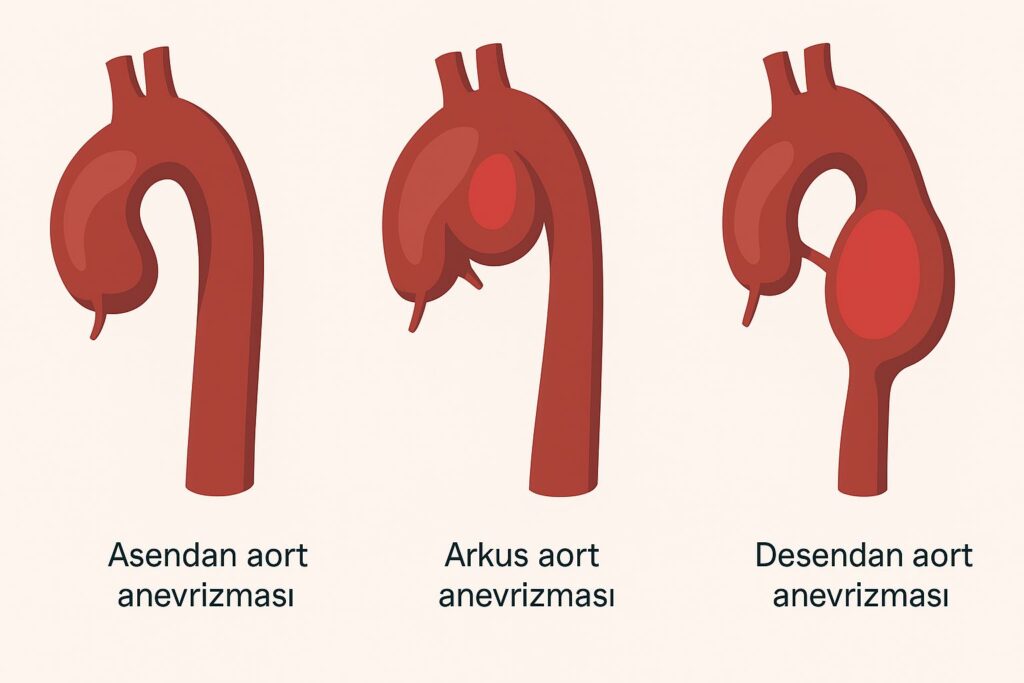Ascending aortic aneurysm is a serious enlargement that occurs in the first section of the main artery (aorta) leaving the heart. This enlargement results from the weakening of the vessel wall over time and loss of its elasticity. This condition, which usually progresses without symptoms, carries life-threatening risks such as rupture (vessel tear), making early diagnosis and monitoring crucial. In this article, we discuss the causes, symptoms, diagnostic processes, and treatment options for ascending aortic aneurysm.

Where is the Ascending Aorta?
The aorta emerges from the left ventricle of the heart and carries oxygenated blood to the entire body. The first section of the aorta as it leaves the heart is called the “ascending aorta” (rising aorta). This region is exposed to the highest blood pressure of any aortic segment and therefore has a higher risk of aneurysm development.
Why Does Ascending Aortic Aneurysm Occur?
Multiple factors play a role in the development of ascending aortic aneurysm. The most common among these are:
- Congenital Aortic Valve Anomalies: The risk increases significantly in individuals with bicuspid aortic valve (aortic valve with two leaflets).
- Connective Tissue Disorders: Genetic diseases such as Marfan Syndrome, Loeys-Dietz Syndrome, and Ehlers-Danlos Syndrome weaken the vessel wall, predisposing to aneurysm formation.
- Family History: The likelihood of occurrence is higher in first-degree relatives with a history of aortic aneurysm.
- Hypertension: Persistent high blood pressure increases the pressure applied to the vessel wall, leading to structural deterioration.
- Advanced Age and Male Gender: It is more common in men over 60 years of age.
What Are the Symptoms?
Ascending aortic aneurysms often progress silently. However, as the aneurysm size increases, some symptoms may appear:
- Chest pain or pressure sensation
- Shortness of breath
- Heart murmur (especially if aortic valve insufficiency has developed)
- Rarely, difficulty swallowing or coughing
When these symptoms are noticed, one should consult a cardiologist without delay.
How is Ascending Aortic Aneurysm Diagnosed?
The most important step in diagnosis is clinical suspicion. Even without symptoms, regular check-ups in individuals at risk are important. The main methods used for diagnosis are:
- Echocardiography (Transthoracic or Transesophageal): The aortic region emerging from the heart can be directly visualized.
- CT Angiography: Allows for precise measurement of the aortic diameter and provides detailed anatomical information.
- MR Angiography: A radiation-free alternative that is preferred in certain special cases.
These imaging methods are generally used to assess the size of the aneurysm, rate of expansion, and whether surgery is necessary.
What are the Treatment Methods?
A treatment plan is made based on the diameter of the aneurysm and the patient’s overall health condition. The treatment approach is as follows:
1. Monitoring and Follow-up
For cases where aortic diameter is between 4.5–5 cm and not showing rapid growth, periodic imaging (6–12 months) is sufficient for follow-up.
2. Open Surgery (Graft Application)
If the aortic diameter exceeds 5.5 cm or the growth rate is more than 0.5 cm per year, open surgery is recommended. In this method:
- The chest bone is opened.
- The heart is temporarily connected to a heart-lung machine.
- The enlarged aortic section is removed, and an artificial vessel (graft) is sutured in its place.
3. Hybrid Surgical Method
Hybrid techniques may be preferred in aneurysms related to the aortic valve and arteries leading to the brain. In this method:
- Some vessels are bypassed without stopping the heart,
- While endovascular grafts are placed in other regions.
Why is Follow-up Important?
One of the most important factors in the treatment of aortic aneurysm is timely intervention. If intervention is made before the aneurysm grows too large, the success rate is high. Additionally, for individuals with bicuspid valve or genetic disease, the surgical threshold can be set lower (for example, 5 cm).
Ascending aortic aneurysm is a health issue that can be successfully treated when detected early, but can lead to serious complications if it progresses. Regular check-ups for individuals with risk factors and paying attention to warning signs can be life-saving.
